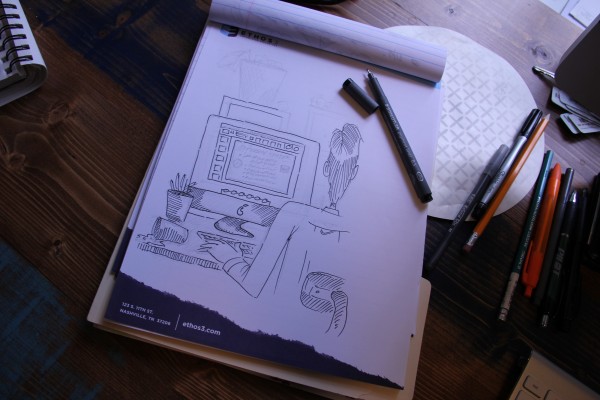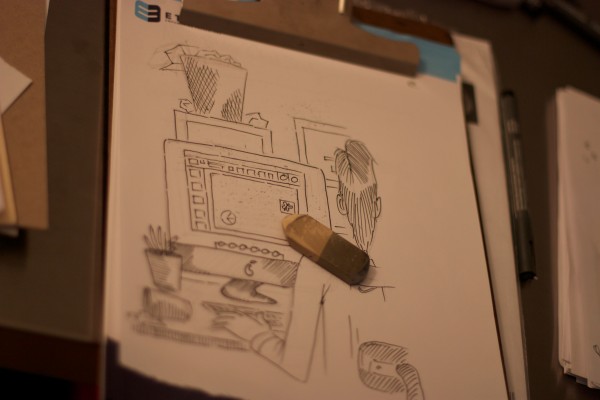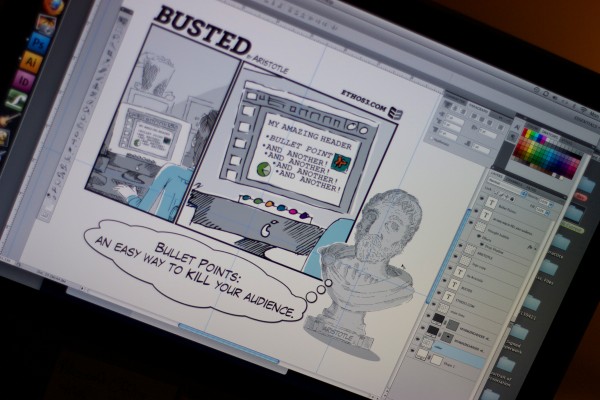Each edition of Busted, the Ethos3 original comic strip series, is the result of many thoughtful strokes of the pen by Ethos3 presentation designer, Chris Stewart. Chris, a 2011 graduate of Watkins College of Art, Design & Film, sat down with Ethos3 Marketing Director, Leslie Belknap, to talk about the value of doodling in class, as well as share tips on utilizing Adobe Illustrator, and most importantly, to dish the Behind the Scenes scoop on the creation of the Busted comic series.
Q: How long have you been illustrating?
A: Honestly, I have been illustrating since I could pick up a crayon. Formally, I studied illustration in college, and graduated with a degree in design.
Q: Who is your greatest inspiration for illustration?
A: Jim Davis of Garfield, and Charles Schultz of Peanuts are great sources of inspiration for me. Charles Schultz is especially encouraging because he did so much with so little, and he wasn’t ashamed of his own line work. Supposedly Disney turned down Charles Schultz because his illustrations and drawings were not clean enough. I don’t know though, maybe that is an urban legend. Schultz has a nervous line quality that is a hallmark of his look. He just embraced it. Jim Davis has a completely different look, and it is super clean. It did not start out quite as clean, but then it turned into something really, really clean – a far cry from Charles Schultz’s look. They are at opposite ends of the illustration spectrum, but they are both comic strips and they are both relatively simple illustrations that inspire me.
Q: Once you receive the content for Busted from the Ethos3 content team, what is your process?
A: I would like to say that I am a disciplined illustrator and start out with a pencil to lay down a sketch. Usually though I just start drawing light lines with a pen to get the basic framework, and then continue to go over it with a pen. I find that I am better off when I don’t overthink it. I can digitally remove any of the excess pen work that I don’t want. I am fortunate enough to have come of age as an illustrator in an era when we have Adobe Illustrator and Photoshop, so I don’t have to worry as much about getting perfect results on the actual page.
Q: When your pen sketch is complete, what is your next step?
A: I do not have a scanner at home, so I stand over the paper and I photograph the sketch. Then I take that digital photograph and I drop it into Adobe Illustrator to vectorize the line work. That makes the sketch malleable for editing. Then I drag the digital image into Photoshop and start adding color underneath. If there are any edits, lines out of place, or any objects that are undesirable, I fix those in Photoshop as well. And that’s pretty much it: I draw it, vectorize it, edit it, and add color.
Q: Do you have a favorite tool in Adobe Illustrator?
A: When I interned for successful children’s book illustrator, Travis Foster, he showed me how to customize the default trace tool. There are a myriad of ways to tweak that default tool, to get a different quality of line. Go into the Illustrator menu, go to live trace, and then tweak things like path fitting, and corner, and other options. You can tweak the width, you can determine how faithful the digital line is to the original sketch, and you can give lines a ribbon quality to get rid of anything rugged from the original drawing. You can go haywire with customizing that tool. I have sat with a single sketch and tweaked the line to the point that it got ridiculous. And that is just one tool in Illustrator. Just like any Adobe software, Illustrator can be intimidating at first, but over the years it becomes more intuitive.
Q: What are your favorite albums for inspiring creativity while illustrating?
A: This is only going to resonate with gaming nerds, but I like to listen to soundtracks, especially the Chrono Trigger video game soundtrack. It is an old Super Nintendo game. I have listened to the soundtrack for years. And Kingdom Hearts – that’s a PS2 game. I really love the soundtrack too.
Q: What is the most challenging part of illustrating Busted?
A: I get very concerned about the consistency of the lines, because I like to try new things every time I sit down to draw. I am guessing that line consistency is something that only an illustrator would obsess over, but that’s been challenging for me – to not obsess over that too much and just lay it down, be happy with the drawing after a certain point, and release it out into the world.
Q: In your spare time, what are your favorite things to illustrate?
A: I am always drawing trees and animals. Also, I obsessively draw Batman and various comic book characters. I used to voraciously devour graphic novels and comic books, so that greatly informed what I like to scribble in my spare time. Also, when I was in school, while the professor was waxing philosophical about something, and I was supposed to be taking notes, I would fill the page with squiggles. Never underestimate the value of a good squiggle. Those squiggles helped shape the way the lines look for a lot of my characters now. Those squiggles didn’t look like anything at the time, but they were important.
Q: What would be your advice to aspiring illustrators?
A: The same advice that Travis Foster gave to me: draw constantly.
Below are some Behind the Scenes photos taken at Chris Stewart’s home studio in Nashville, TN. Check back often for more Busted updates from the Ethos3 team.



